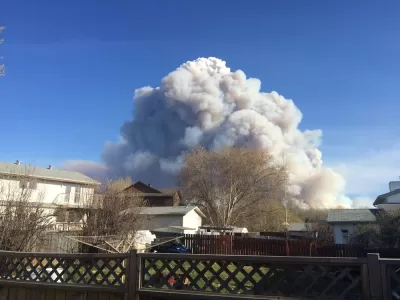Along with climate conditions, urban sprawl is intensifying wildfires and increasing the damage they do.

In light of the recent evacuations in Alberta and the seemingly never-ending fire season in California, worsening fires throughout North America have been attributed to the impacts of climate change. But Undark notes that patterns of human development can also make fires more dangerous.
For one, "the population in an area, where people live, and how many roads there are, all affect the behavior of fires and their risk to people."
More development at the edge of urban areas and wildlands could make the consequences of fires there much greater.
“For some of the problems like, home losses, or fatalities, or evacuability of our fire prone communities, or budgets — how many hundreds of millions of dollars are spent each year on fire suppression — a lot of that comes back to something that is not a fuels problem, it’s an issue of where and how we built our human developments,” [researcher Max Moritz] said.
The more of these problems the U.S. Forest Service and local fire departments have to deal with, the more resources they have to expend on each fire.
And one theory argues that the long-standing strategy of suppression—which can ultimately lead to bigger, wilder fires—also grew from the shift to fossil fuels and a new power infrastructure during the industrial revolution.
FULL STORY: The Push and Pull of Forest Fire Management

Study: Maui’s Plan to Convert Vacation Rentals to Long-Term Housing Could Cause Nearly $1 Billion Economic Loss
The plan would reduce visitor accommodation by 25,% resulting in 1,900 jobs lost.

North Texas Transit Leaders Tout Benefits of TOD for Growing Region
At a summit focused on transit-oriented development, policymakers discussed how North Texas’ expanded light rail system can serve as a tool for economic growth.

Why Should We Subsidize Public Transportation?
Many public transit agencies face financial stress due to rising costs, declining fare revenue, and declining subsidies. Transit advocates must provide a strong business case for increasing public transit funding.

How to Make US Trains Faster
Changes to boarding platforms and a switch to electric trains could improve U.S. passenger rail service without the added cost of high-speed rail.

Columbia’s Revitalized ‘Loop’ Is a Hub for Local Entrepreneurs
A focus on small businesses is helping a commercial corridor in Columbia, Missouri thrive.

Invasive Insect Threatens Minnesota’s Ash Forests
The Emerald Ash Borer is a rapidly spreading invasive pest threatening Minnesota’s ash trees, and homeowners are encouraged to plant diverse replacement species, avoid moving ash firewood, and monitor for signs of infestation.
Urban Design for Planners 1: Software Tools
This six-course series explores essential urban design concepts using open source software and equips planners with the tools they need to participate fully in the urban design process.
Planning for Universal Design
Learn the tools for implementing Universal Design in planning regulations.
City of Santa Clarita
Ascent Environmental
Institute for Housing and Urban Development Studies (IHS)
City of Grandview
Harvard GSD Executive Education
Toledo-Lucas County Plan Commissions
Salt Lake City
NYU Wagner Graduate School of Public Service




























